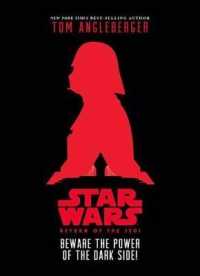Full Description
A cutting-edge model for 21st century curriculum and instruction
How can you spot a thinking child? Look at the eyes: they'll light up, signaling that transformative moment when your student has finally grasped that big idea behind critical academic content. If experiences like this are all too rare in your school, then you need a curriculum and instruction model that's more inquiry-driven and idea-centered. Now.
H. Lynn Erickson and Lois Lanning demonstrate how, through concept-based curriculum, you can move beyond superficial coverage and lower-level skills practice to effect intellectually engaging pedagogy, where students engage in problem finding and problem solving. New insights include:
How to design and implement concept-based curriculum and instruction across all subjects and grade levels.
Why content and process are two different (but equally important) aspects of any effective concept-based curriculum.
How to ensure students develop the all-important skill of synergistic thinking.
We're all looking for the best curriculum and instruction model to meet the changing demands of the 21st century. This is it.
"With the onset of the Common Core and new national content standards, concept-based learning is now more crucial than ever. Erickson and Lanning are 'ahead of the curve' in providing teachers and curriculum leaders with rich instructional strategies to meet these challenging standards. This is an essential book for planning tomorrow's curricula today."
Douglas Llewellyn, Educational Consultant and Author of Inquire Within, Third Edition
"Powerful teaching engages minds with powerful ideas. At its core, such transformative teaching is neither transmission of information nor practice with inert skills. Rather it is a careful choreography between a mind and an idea such that the mind comes to own the idea in a form that is true to the discipline and expansive for the learner. Erickson and Lanning teach teachers to be choreographers of learning—understanding both what makes content worth knowing and how to engage young minds with that content in ways that extend their capacities to understand it at a deeper level, use it, transfer it, and ultimately create with it."
Carol Ann Tomlinson, Ed.D., Chair of Educational Leadership, Foundations, and Policy
Curry School of Education, University of Virginia
Contents
List of Figures and Tables
Foreword by Malcolm Nicolson
Acknowledgments
About the Authors
Introduction
Purpose of the Book
Audiences
Chapter Overview
Chapter 1. Curriculum Design: From an Objectives-Based to a Concept-Based Model
A Short Retrospective, From the Authors, on Educational Swings
The Value of Know, Understand, and Able to Do in Concept-Based Models
Problems With Traditional Content Objectives
Discussion Questions
Summary
Chapter 2. Two-Dimensional Versus Three-Dimensional Curriculum Models
Contrasting the Two-Dimensional and Three-Dimensional Models
Introducing the Structures of Knowledge and Process
The Interplay of Process and Knowledge
Contrasting Instructional Descriptions
Discussion Questions
Summary
Chapter 3. The Structure of Knowledge
Understanding the Relationships in the Structure of Knowledge
How the Structure of Knowledge Guides Curriculum Design
Designing Disciplinary Curriculum Frameworks at the National, State, or Local Levels
Mathematics as a Concept-Driven Discipline
Examples of Concepts and Subject-Specific Generalizations
Discussion Questions
Summary
Chapter 4. The Structure of Process
The Structure of Process
How the Structure of Process Guides Curriculum and Instruction
Discussion Questions
Summary
Chapter 5. The Developing Concept-Based Teacher
Bridging the Gaps Between Knowing, Doing, and Understanding
Collaborative Concept-Based Lesson Planning
Common Terminology Used to Describe Quality Instruction
The Developing Concept-Based Teacher
Do The Developing Concept-Based Teacher Rubrics Have a Place in Teacher Evaluation Plans?
Discussion Questions
Summary
Chapter 6. The Developing Concept-Based Student
What About Thinking?
The Relationship Between Critical Thinking and Concept-Based Teaching and Learning
Developing Critical Thinking
The Developing Concept-Based Student
Why These Categories?
Discussion Questions
Summary
Chapter 7. What Do Teachers Need to Understand About Concept-Based Pedagogy?
The What and Why of Concept-Based Curriculum and Instruction
The How of Concept-Based Curriculum and Instruction
Four Critical Aspects of Concept-Based Pedagogy
Quality Pedagogy
Concept-Based Classrooms
Discussion Questions
Summary
Chapter 8. What Do Principals and Instructional Coaches Need to Understand? Implementing and Sustaining Concept-Based Curricular and Instructional Models in Schools
Setting the Stage for Curriculum Implementation
Staff Development
Staff Support With Accountability: Building System-Wide Synergy
The Collection and Analysis of the "Right" Data
Discussion Questions
Summary
Chapter 9. What Do District Leaders Need to Understand About Concept-Based Curriculum Designs?
District Leaders Discuss Concept-Based Curriculum and Instruction
Discussion Questions
Summary
Chapter 10. Summary and the Road Ahead
Curriculum and Instruction: The Warp
Concept-Based Learning: The Weft
The Path Forward
Discussion Questions
Resources
Resource A. Concept-Based Mathematics Unit
Resource B. Concept-Based Science Unit
Resource C. Concept-Based Art Unit
Resource D. Concept-Based World Language Unit
Resource E. Concept-Based Music Unit
Resource F. Adapted Learning Activities for Chapter 7
References
Index








